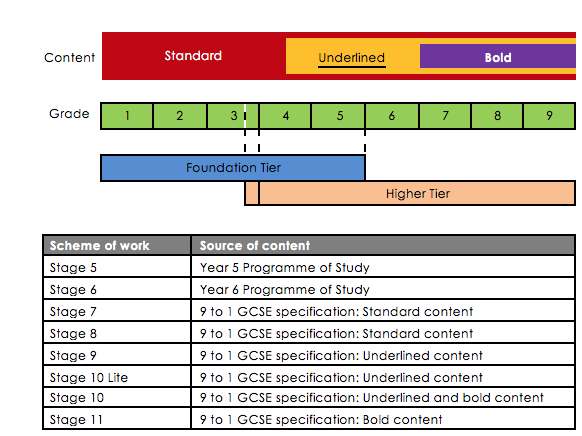Key Stage 3/4
Schemes of work for the 2014 curriculum
And a framework for assessment based on the Kangaroo Maths BAM Indicators
These schemes of work are based on a model of progression which is part of a wider picture. They are designed to be used according to the prior attainment of students at primary school, and the way in which they are used might well evolve as the 2014 curriculum embeds. For information about the content of the units, see the medium term plans (the 'Stage X Mathematics' jigsaw diagrams) and the big picture progression map. For information about the design and structure of the schemes of work, please read these explanatory notes.
The schemes of work were significantly updated in August 2017. There has been the occasional reordering of units in Stages 5, 6 and 7. If the older versions are required then they can be accessed by links at the bottom of this page.
| 11-16 Pathway | ||
|---|---|---|
| Below expected standard at end of KS2 | Expected standard at end of KS2 | |
| Stage 6 | Stage 7 | Year 7 |
| Stage 7 | Stage 8 | Year 8 |
| Stage 8 | Stage 9 | Year 9 |
| Stage 9 | Stage 10 | Year 10 |
| Stage 10 Lite | Stage 11 | Year 11 |
For those students significantly below the expected standard at the end of KS2, you can find the connected Stage 5 scheme of work here.
We have decided to use the word 'stage' to organise these pathways as it is the language used in the National Curriculum extract below. The quote also explains why there is no third 'extension' pathway in this table.
-
"The expectation is that the majority of pupils will move through the programmes of study at broadly the same pace. However, decisions about when to progress should always be based on the security of pupilsí understanding and their readiness to progress to the next stage. Pupils who grasp concepts rapidly should be challenged through being offered rich and sophisticated problems before any acceleration through new content. Those who are not sufficiently fluent with earlier material should consolidate their understanding, including through additional practice, before moving on."
Features of the schemes of work include links to suitable activities from NRICH (a site updated every month with new activities based on a mathematical theme)
The diagram below explains the source of content used for each of the secondary schemes of work, and their consequent pitch in terms of GCSE grades. It is based on a diagram originally provided by OCR.

Pre August 2017 schemes of work
